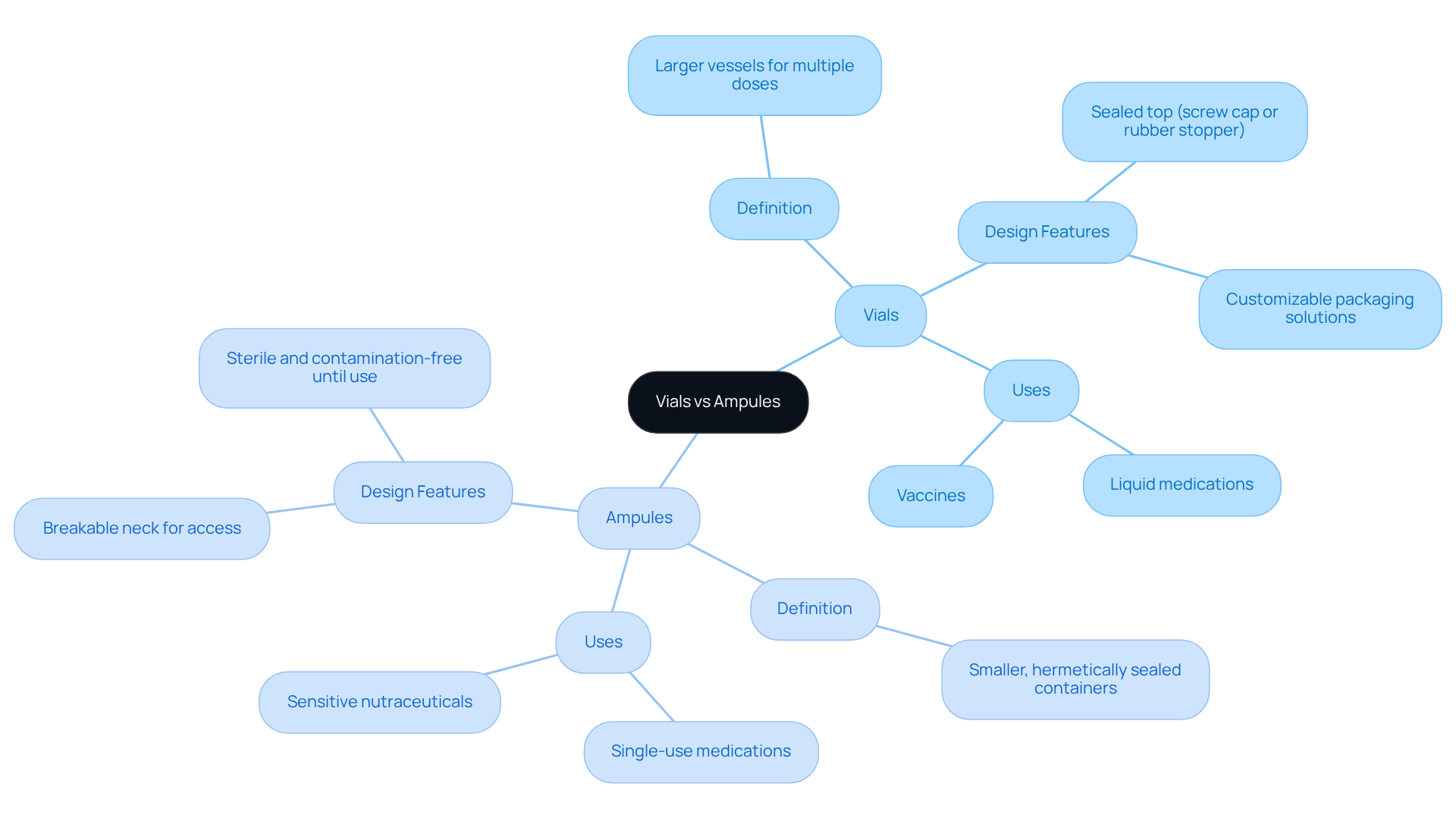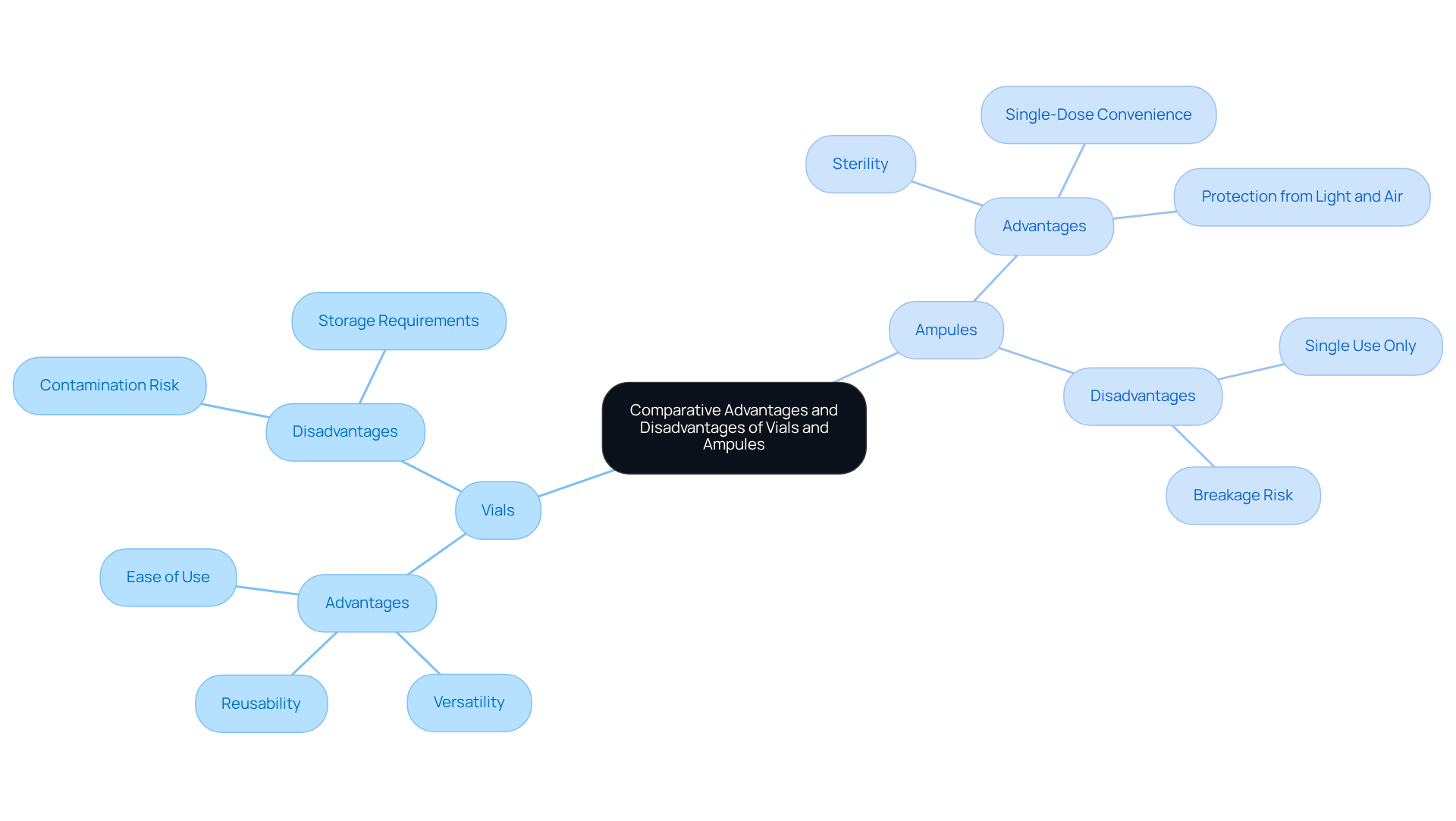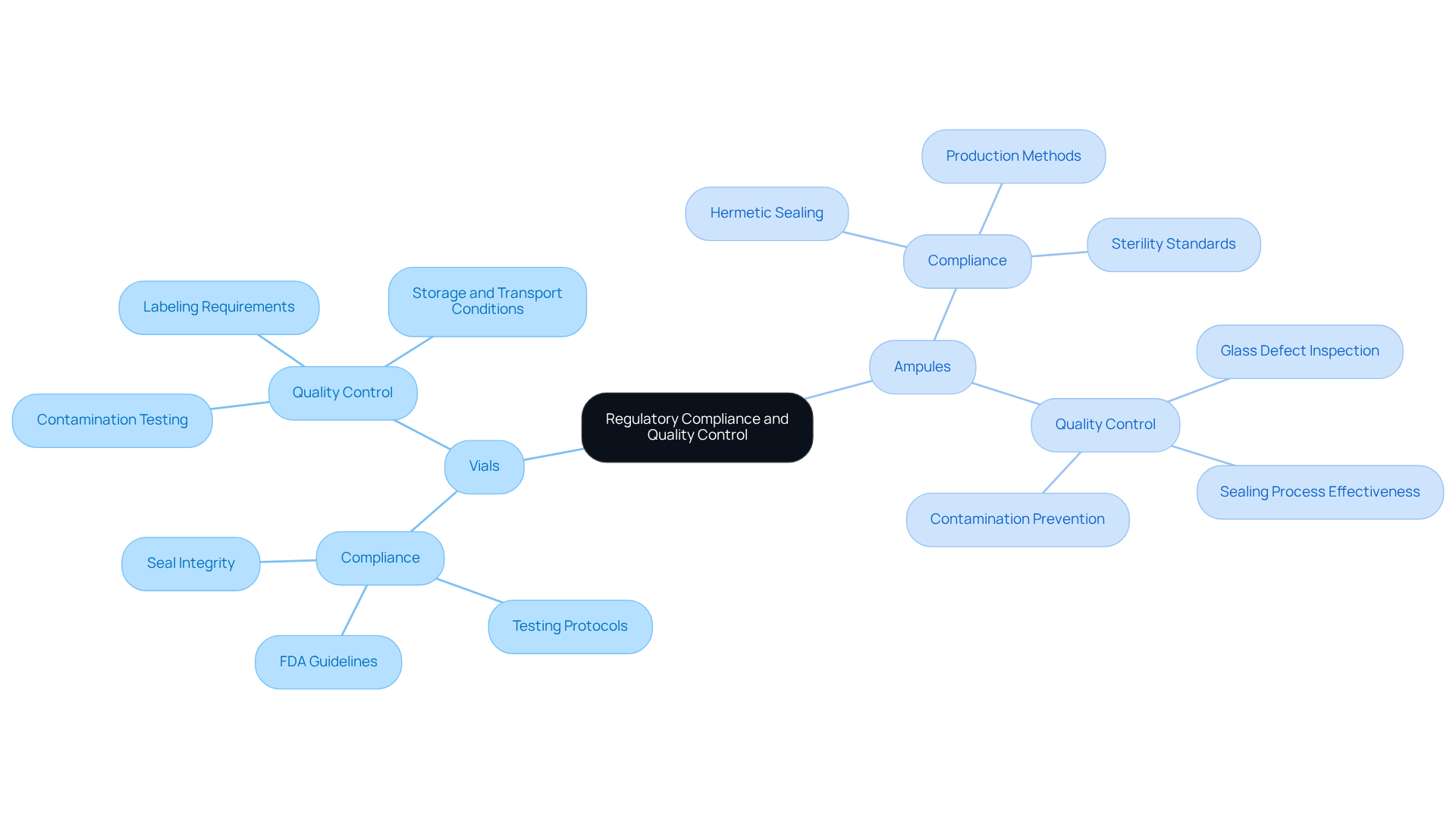Overview
The key differences between vials and ampules in nutraceutical packaging are critical to understand for effective application. Vials, known for their reusability, are suitable for multiple doses, making them a preferred choice in various scenarios. In contrast, ampules provide a single-use solution, hermetically sealed to ensure sterility. This article elaborates on these distinctions, detailing the benefits and drawbacks of each type.
For instance, while vials present a risk of contamination after opening, ampules offer superior protection from environmental factors. This emphasizes the importance of regulatory compliance and quality control for both packaging options, underscoring the necessity for industry professionals to choose wisely for optimal results.
Introduction
In the intricate world of nutraceutical packaging, the choice between vials and ampules significantly impacts product integrity and consumer experience. Vials, designed for multiple doses, offer flexibility and convenience. In contrast, ampules ensure sterility with their single-use design, catering to sensitive compounds. This comparison raises critical questions:
- Which option truly meets the demands of safety, usability, and regulatory compliance in a competitive market?
- Understanding the distinct advantages and disadvantages of each container type is essential for manufacturers aiming to optimize their packaging strategies.
Understanding Vials and Ampules: Definitions and Uses
Containers serve essential packaging functions in the pharmaceutical and nutraceutical industries, highlighting the differences between vial vs ampule. Containers, typically larger vessels crafted from glass or plastic, are designed to hold multiple doses of liquids, solids, or powders. These vessels feature a sealed top, which may be a screw cap or a rubber stopper, facilitating easy access and resealing after opening. When considering vial vs ampule, vials are commonly employed for items requiring multiple doses, such as vaccines or liquid medications. By leveraging Western Packaging's customized flexible packaging solutions, manufacturers can enhance the shelf appeal of vials through distinctive design features and materials, enabling their products to stand out in a competitive market.
Conversely, in the discussion of vial vs ampule, ampules are smaller, hermetically sealed containers, usually made of glass, intended for single-use. They contain a single dose of medication or supplement, accessed by breaking the neck of the container. This design guarantees that the contents remain sterile and protected from contamination until the moment of use. Ampules are particularly suited for unstable compounds that necessitate immediate use post-opening, such as certain injectable medications or sensitive nutraceuticals. By utilizing advanced packaging design solutions from Western Packaging, nutraceutical producers can bolster brand visibility and ensure their containers are both functional and visually appealing, effectively addressing the specific challenges faced in the market.

Comparative Advantages and Disadvantages of Vials and Ampules
When comparing vials and ampules, several factors come into play:
Advantages of Vials:
- Reusability: Vials can be resealed and reused, making them cost-effective for products that require multiple doses.
- Versatility: They can accommodate a variety of substances, including solids, liquids, and powders.
- Ease of Use: The screw cap or stopper allows for straightforward access and dosing.
Disadvantages of Vials:
- Contamination Risk: Once opened, vials are exposed to air, which can lead to contamination and degradation of the product.
- Storage Requirements: They may require specific storage conditions to maintain item integrity after opening.
Advantages of Ampules:
- Sterility: Ampules are sealed until use, ensuring that the contents remain uncontaminated.
- Single-Dose Convenience: They are ideal for single-use applications, reducing the risk of dosing errors.
- Protection from Light and Air: The sealed design protects sensitive compounds from environmental factors that could compromise their efficacy.
Disadvantages of Ampules:
- Single Use Only: Once opened, ampules cannot be resealed, leading to potential waste if not all contents are used.
- Breakage Risk: The glass design can present a risk of breakage, which may lead to injury or loss.

Regulatory Compliance and Quality Control in Vial and Ampule Packaging
Both vial vs ampule and containers must adhere to stringent regulatory standards to ensure the safety and effectiveness of the products they contain.
Regulatory Compliance:
- Vials: Compliance with guidelines established by organizations such as the FDA and EMA is essential. These guidelines dictate the materials used, labeling requirements, and testing protocols to ensure that vials do not leach harmful substances into their contents.
- Vial vs Ampule: Similarly, ampules must adhere to strict regulations regarding their production methods, components, and sterility, just like vials. The hermetic sealing of ampules is particularly scrutinized to guarantee that they maintain sterility until opened.
Quality Control:
- Vials: Quality control measures are critical and include testing for seal integrity, contamination, and proper labeling. Manufacturers must ensure that vials can withstand the conditions encountered during storage and transport.
- Ampules: For ampules, quality control focuses on ensuring that the glass is free from defects and that the sealing process is effective. Regular inspections are necessary to prevent issues such as glass particles contaminating the contents.
In conclusion, both packaging types, such as vial vs ampule, necessitate rigorous quality control and compliance measures to meet the essential safety standards for nutraceutical products.

Conclusion
Understanding the distinctions between vials and ampules is crucial for effective nutraceutical packaging. Both serve the essential function of containing products, yet they cater to different needs and applications within the pharmaceutical landscape. Vials offer versatility and reusability, making them ideal for multiple doses. In contrast, ampules provide a sterile, single-use solution that protects sensitive compounds until needed.
The advantages and disadvantages of each container type are significant:
- Vials are cost-effective and easy to use, but they pose contamination risks once opened.
- Conversely, ampules ensure sterility and protection from environmental factors, though they are limited to single-use and can be prone to breakage.
Furthermore, the importance of regulatory compliance and quality control measures cannot be overstated; both packaging types must adhere to stringent standards to ensure safety and efficacy.
Ultimately, the choice between vials and ampules should be guided by the specific needs of the product and the target market. Understanding these differences not only aids manufacturers in selecting the appropriate packaging but also enhances product integrity and consumer safety. As the nutraceutical industry continues to evolve, leveraging the right packaging solutions will be paramount in maintaining product quality and meeting regulatory requirements.
Frequently Asked Questions
What is the primary difference between vials and ampules?
The primary difference is that vials are designed for multiple doses and can be resealed, while ampules are hermetically sealed containers meant for single-use only.
What are vials commonly used for?
Vials are commonly used for items that require multiple doses, such as vaccines or liquid medications.
How do vials facilitate access to their contents?
Vials typically feature a sealed top that may be a screw cap or a rubber stopper, allowing for easy access and resealing after opening.
What are ampules made of and how are they accessed?
Ampules are usually made of glass and are accessed by breaking the neck of the container to release a single dose of medication or supplement.
Why are ampules particularly suited for certain compounds?
Ampules are particularly suited for unstable compounds that require immediate use after opening, such as certain injectable medications or sensitive nutraceuticals.
How can manufacturers enhance the appeal of vials?
Manufacturers can enhance the shelf appeal of vials through distinctive design features and materials, leveraging customized flexible packaging solutions.
What advantages do advanced packaging design solutions offer to nutraceutical producers?
Advanced packaging design solutions help nutraceutical producers bolster brand visibility and ensure their containers are both functional and visually appealing.




